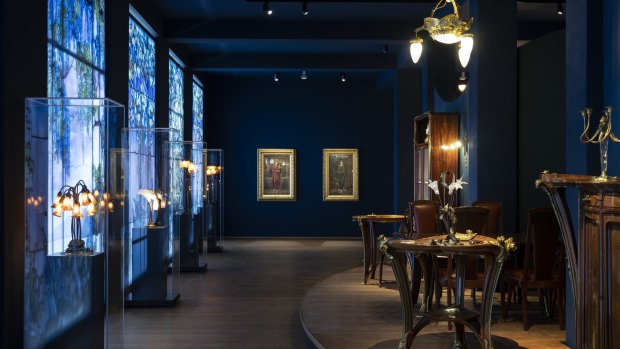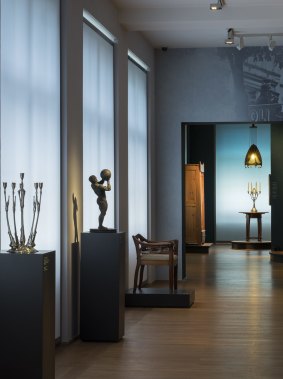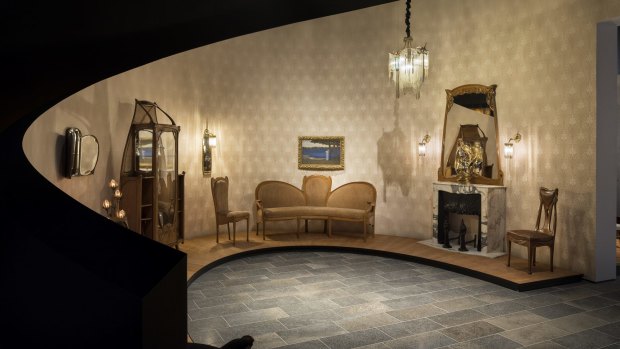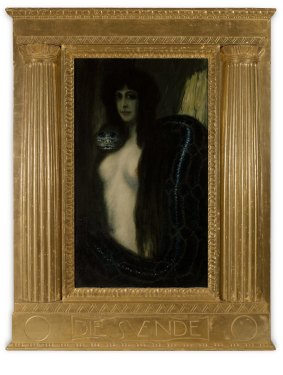This was published 4 years ago
Museum Wiesbaden, Germany: Where to see of one of Europe's largest collections of art nouveau treasures
By Ute Junker

The collection at Museum Wiesbaden.Credit: Bernd Fickert
Anyone who has moved house knows that shifting furniture can be an ordeal. When you are shifting hundreds of pieces of priceless art nouveau furniture, however, the frustration factor ratchets up considerably.
"These tables are incredibly heavy, particularly if you are used to modern furniture," says Caren Jones, gesturing at an elegant mahogany dining table. "To carry them through the house and up and down stairs you need at least six men – you need as many men as can fit their hands on the table."
She gestures at exquisite porcelain tea sets that are displayed nearby. "These are so fragile. You can wrap them and put them into a box and it still weighs nothing. We had to label every side of the box, because otherwise people would assume it was empty."

Museum Wiesbaden houses an extensive collection of art nouveau treasures.Credit: Bernd Fickert
As the registrar for Museum Wiesbaden, Jones was responsible for ensuring the safe arrival at the museum of an incredible bequest: one of the largest collections of art nouveau furnishings, paintings, sculpture and glassworks in Europe. Gathered over 40 years by Ferdinand Wolfgang Neess, scion of a local dynasty of industrialists, the collection was transported to the museum straight from the Neess family residence.
"We have tried to keep some of the atmosphere of how these objects were set up in the home," Jones explains as she walks us through the first of five display rooms. Designing objects for the home was an important part of the art nouveau movement, which aimed to bring art into the everyday, and the Neess collection demonstrates how enthusiastically the designers of the era embraced the challenge.
There are vases and dining tables, candelabras and side boards, chandeliers and glass lamps, the latter displayed with lightbulbs blazing, as they were designed to be seen.

Art nouveau furniture on display at Museum Wiesbaden, Germany.Credit: Bernd Fickert
Beyond the beauty of the pieces, the mix of candelabras and artificial lights is a reminder that, like our era, the early 19th century was a time of considerable technological change.
"The fact that you see so many gas lamps as well as candelabras shows you that this was a time of change. Electricity was still very new," Jones says.
The collection includes pieces by some of the most esteemed art nouveau designers, from Charles Tiffany to Emile Galle. There are also paintings by the likes of Franz von Stuck as well as exquisite bronze busts by Alphonse Mucha which feature jewellery made with lapis lazuli. Jones says that much of the furniture is remarkable for the sheer amount of effort it took to make.

The collection includes paintings such as Stuck's The Sin. Credit: Markus Bollen
"Take a look at that," she says, gesturing at a large mirror created by Jacques Gruber almost 120 years ago. The piece has a carved mahogany frame inset with coloured glass and ornamented with exquisite lamp shades shaped like tulips. "It is all about the details. These people were trying to deliver artistic manufacture on an industrial scale."
While the museum has been gifted an incredible selection of treasures, Jones promises that Neess and his wife have not been left with an empty house. "We only have part of the collection. We may have three of their dining tables, but they still have one left. And he is still buying new pieces."
TRIP NOTES
Ute Junker travelled courtesy of the German National Tourism Office and Rail Europe.
MORE
VISIT
Wiesbaden is about 45 minutes from Frankfurt with rail connecting the two. The Neess Collection is on show at the Museum Wiesbaden. See raileurope.com.au; museum-wiesbaden.de
STAY
The Radisson Blu Zum Schwarzer Bock has centuries of history and its own thermal spa. From €125 a night. See radissonblu.com
Sign up for the Traveller Deals newsletter
Get exclusive travel deals delivered straight to your inbox. Sign up now.